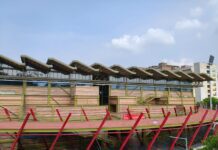In a landmark move, the Maharashtra government has greenlit the development of India’s first offshore airport near Vadhavan Port, set to become Mumbai Metropolitan Region’s (MMR) third aviation hub after Chhatrapati Shivaji Maharaj International Airport and Navi Mumbai International Airport. The ₹76,220 crore project is expected to begin preliminary work in 2026, following the completion of a detailed project report (DPR) and feasibility studies.
Strategically located off the coast of Palghar district, adjacent to the under-construction Vadhavan deep-water port, the offshore airport will leverage shared marine infrastructure and boost port-linked economic activity. The Grant Thornton–Nippon Koei India joint venture has already secured the pre-feasibility contract, with DPR submission expected in the coming months.
A significant feature of the Vadhavan airport project is its reliance on steel-intensive construction, in line with global offshore aviation models such as those in Hong Kong and Osaka. Offshore platforms will require marine-grade steel piles, beams, and load-bearing decks engineered to withstand corrosive saline environments and high dynamic loads.
Further, the terminal buildings and hangars are likely to be constructed using long-span structural steel frames, pre-engineered building (PEB) systems, and composite steel–concrete decking-offering both flexibility and accelerated timelines. Runways and taxiways will incorporate modular steel support systems, including steel-reinforced decking and foundation substructures designed for floating or semi-floating platforms.
The airport will also integrate with major infrastructure corridors like the Mumbai–Ahmedabad bullet train, Delhi–Mumbai expressway, and Mumbai–Pune expressway, necessitating steel bridges and elevated corridors.
If executed as planned, Vadhavan Offshore Airport will redefine India’s coastal aviation model and cement steel’s pivotal role in modern, resilient infrastructure.






[…] Vadhavan to Host India’s First Offshore Airport […]
Comments are closed.